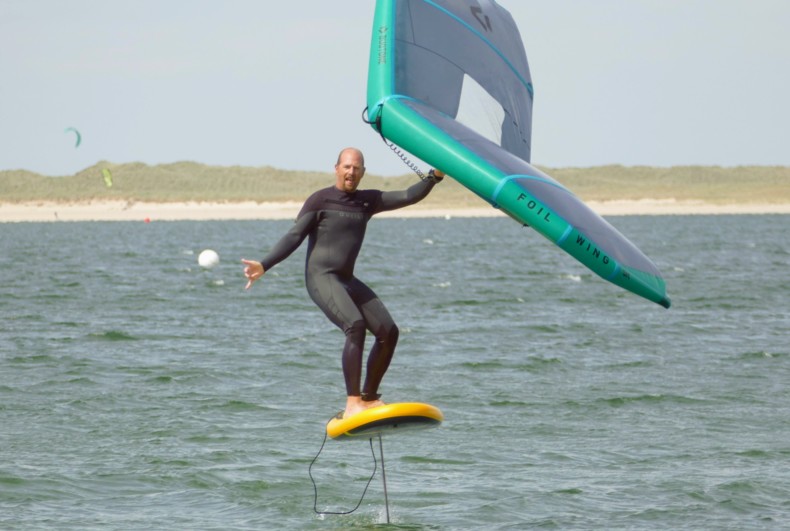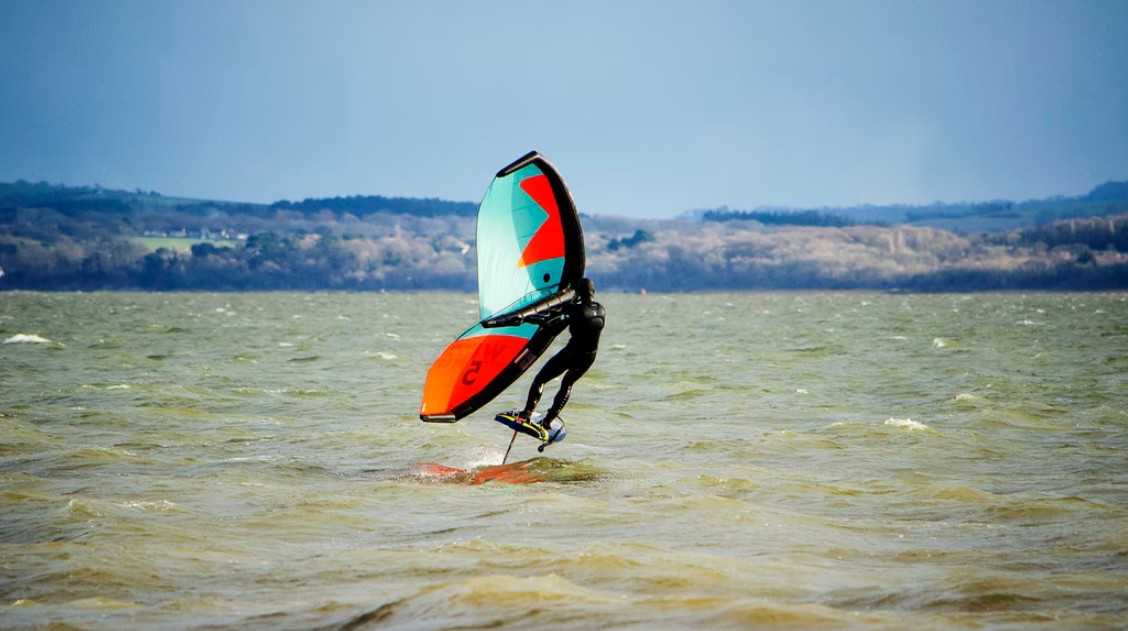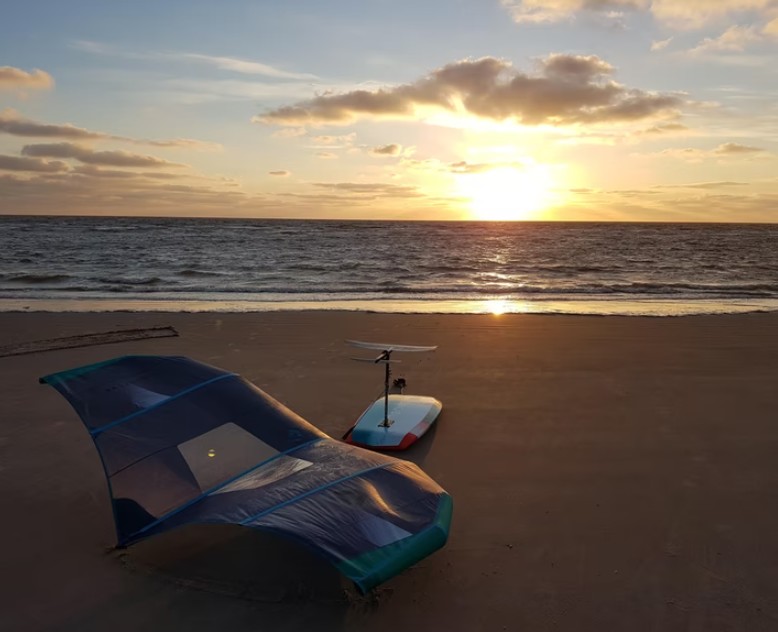A new sport called wing foiling has recently taken the wind and water worlds by storm. It’s the hottest, new watersport of this generation. But what exactly is it? Read more to learn what it is, its history, its equipment, and how you can take a chance at it.
Introduction
Wing foiling is a water sport that’s a little bit of surfing (as you stand on a board to ride waves), a little bit kitesurfing (as a kite pulls you as you stand on a board), and a little bit windsurfing (same as surfing but with a sail attached to the board). Combine these three water sports, trim off the excess, and you get wing foiling. Technically, wing foiling is windsurfing above the water on a hydrofoil.
The beauty of using hydrofoils is they are so efficient in lifting, and they don’t need a breaking wave to move, unlike with surfboards. It makes open and unbroken ocean swells accessible. Even without the swell, the wing harnesses the wind that gives
This sport will let you experience the feeling of levitating over water while being powered by the wind, as you’re holding an inflatable wing and standing on a board with only an attached hydrofoil in the water. Sometimes called winging, wing foiling offers a sleeker and more user-friendly waterborne package that needs less wind to work. Also, the whole set-up is travel-friendly, especially when compared to the bulk of kitesurfing kites, harnesses, and cords, as well as the size of windsurfing boards, sails, and booms. Many kitesurfers and windsurfers are changing their sport and taking up winging for these reasons.
History of Wing Foiling
As to when wing foiling began, it’s hard to find a video of someone doing the sport before 2017. The first commercial wing was only released in 2018. It is so new, but the sport has seen rapid growth with different disciplines branching off. In late 2020, the first freestyle event was held where the participants launched themselves and their equipment into a different flip and spin combinations.
People are now wing foiling on flat water in harbors and lakes, and when there is swell in the ocean, they do long-distance downwinders.
According to Tim Blanchard, owner of Canada’s first kiteboarding instruction company, Surf Culture Canada, wing foiling began with American big-wave surfer Laird Hamilton. Hamilton apparently started using the foil in Hawaii during the early 2000s and rigged up snowboard bindings to the foil so he would be clamped in and then be towed into the waves with a jet ski.
Laird Hamilton was once labeled “the world’s most complete surfer” by Surf Magazine, and he’s known for being an influencer behind many surfing innovations, including stand-up paddleboarding, tow-in surfing, and hydrofoil boarding.
However, his early renditions of wing foiling were not ready to take to the water and air just yet. According to Blanchard, wing foiling caught on for a while, but it was hard to do. Since the winger is attached directly to the board, you will be stuck upside down under the water if you are wiped out. Only the pros could experiment with it, so there was not a lot from the general population trying the sport.
But since wind sport enthusiasts don’t give up easily, different renditions of the hydrofoil board were developed, and the research began to pay off. Hydrofoil board designs improved, so by 2010, it was common to see boards being used for kiting sessions due to the tremendous amount of movement, speed, and flexibility they provided. By then, the boards were ready, but the wings weren’t yet.
The first actual iteration of the wing foiling wing appeared in the 1980s to 1990s. Windsport enthusiasts would use what was called “wind weapon,” which is a kiteboard-type set up with a boom that hinged and allowed the windsurfing board to levitate. However, it didn’t really take off either, as those wings did not really work with the non-hydrofoil board. Only recently, the hydrofoil and hand wing came together as a pair, and the sports wing foiling came to life.
As an advanced form of windsurfing, wind foiling will be included in Olympics 2024 as a new event. The foiling equipment is being tested for safety, security, and broadcast appeal to be debuted just in time for the 2024 Summer Olympics.
Equipment for Wing Foiling
If you want to start wing foiling and are ready to buy some gear, here are the equipment you’ll need:
1. Wing
Wings for wing foiling are still in the early stages of development, but the wind sports world has already seen great strides in performance and ease of use. These wings come in different sizes, and the wing that you use is dependent on your weight, strength of the wind, and how buoyant your board is.
Wing sizes come in three, four, five, and six meters. As a beginner, you will most likely start with one wing. A good starting wing is a 4m wing for anyone weighing up to 70kg and a 5m wing for anyone over that weight.
Despite their odd-looking size, they are pretty simple to inflate. Depending on the manufacturer, it comes with either soft handles running along the center strut or a hard boom attached to the center strut from tip to tail – these are your options on how you will hold the wing.
2. Boards
The hydrofoil board is a lot like a surfboard with a small airplane attached to the bottom. It shoots a couple of feet off the bottom of the board, and when you speed up in the water, the foil helps raise the board up and out of the water. Rising up reduces friction with the water so that the foiler can achieve faster speeds. The hydrofoil also makes it possible to make sharper and quicker turns.
When beginning with the sport, it helps if you start on a slightly smaller board since you need a good balance when choosing a bigger board. As a rule of thumb, the more advanced you get, the smaller board you will want to ride.
3. Foils
Hydrofoils are usually referred to as foils. It’s made up of a mast, fuselage, and wings. When choosing a foil, look for something stable with a good glide and plenty of lift. For beginners, you want to look for foils that don’t need a lot of speed to get up so you can get wing foiling at slower speeds. This is crucial for learning the sport safely and effectively. Look for foil wings that allow speeds of 10 to 12 km on the low end.
Is it Easy to Start Wing Foiling?
Honestly, starting to do wing foiling takes a lot of learning curve, especially if you’re not experienced with windsurfing and kitesurfing. The wing can be hard to manage when you first start out, and the act of balancing on a rising foil must be mastered, so you can enjoy wing foiling.
If you don’t have a foil or a board, a great way to get the feel of it is on a skateboard and a large, flat, empty concrete area around. If you’re near a lake, harbor, or area of flat water, you can use a stand-up paddleboard. They are stable and easy to get back into in case you fall off. Trying out stand-up paddleboarding will help you get the feel of the power of the wing.
Wing foiling is a sport dependent on elements like wind and water. A thorough understanding of the wind and the ocean (or any body of water) is highly recommended before attempting to learn this sport. Familiarize yourself with weather patterns and get comfy with reading the wind.
The best way to learn the sport is by taking wing foiling lessons. Unless you are skillful with the water, or if you already kiteboard or windsurf, you can get away with having a friend show you the ropes. But if you’re a total newbie to watersports, you can learn with a trained instructor.
When learning how to wing foil, you have to remember these basic tips:
- Stay away from waves and chops when you’re starting out.
- Make sure your wrist leash is attached tightly to your wrist – you don’t want it to fly away and get lost in the ocean.
- Always wear a helmet because the foil is sharp.



